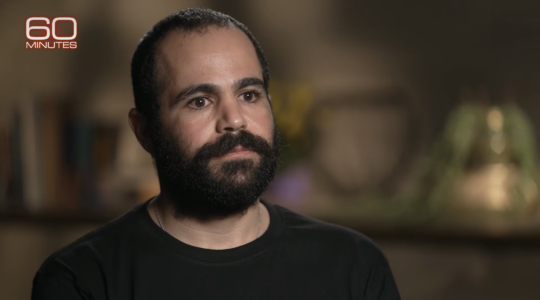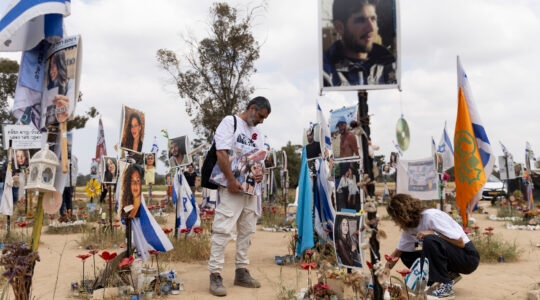JERUSALEM (JTA) — The entrance to the neighborhood of Givat Hamatos isn’t immediately apparent. Accessible only from the winding roads of the Arab community of Beit Safafa next door, or via a sharp right off the five-lane Hebron Road, the eastern Jerusalem hilltop that once hosted caravan housing for immigrant Ethiopians and Russians is now the focus of international controversy.
The Israeli government recently announced plans to build 2,600 housing units in the vicinity of Givat Hamatos. Together with nearby Gilo and Har Homa, the new neighborhood in Givat Hamatos would create a near-contiguous chain of Jewish neighborhoods along the Jerusalem’s southern fringe, all in portions of the city captured in the 1967 Six-Day War.
While the Israeli government has been adamant in asserting a right to build in all parts of its capital city, foreign governments have criticized the planned construction. The Palestinians and Israeli peace activists see the Givat Hamatos plan as a land grab and part of an effort to cut off eastern Jerusalem’s Arab neighborhoods, which the Palestinians envision as their future capital, from the West Bank.
Palestinians’ negotiator Saeb Erekat said in a statement that the location of Givat Hamatos makes it “one of the most damaging settlements” that will “turn the Palestinian town of Beit Safafa into a ghetto” because the site is between the Jerusalem Arab neighborhood and the West Bank city of Bethlehem.
“As we approach Christmas,” Erekat said, “for the Palestinians in Bethlehem, who live just a few kilometers away from the Holy City, Jerusalem might as well be on another continent.”
Not all of the planned housing, however, is intended for a new Jewish neighborhood. Under the plan, 800 of the new housing units are intended as an expansion of Beit Safafa, a comfortably middle-class Arab neighborhood of approximately 5,500 people that has an unusual history and is home to a joint Arab-Jewish school.
Following the 1948 War of Independence, Beit Safafa was divided, with half in the Jordan-occupied West Bank. After Israel’s victory in the 1967 Six-Day War, the two parts were reunited within Israeli Jerusalem’s expanded municipal boundaries, but the Palestinian residents of eastern Beit Safafa today mostly hold Jerusalem identity cards, while the residents of the western portion of the neighborhood are Israeli citizens.
But while international attention has focused on what the new development means for Israeli-Palestinian relations and the struggle for Jerusalem, the story also has an overlooked element. For the dozen down-on-their-luck Israeli families who are still living in caravans on the hill — long after most of the hill’s residents have decamped for more settled environs – the planned construction has stirred a sense of uncertainty about their future.
“I don’t know where my parents will go,” said Barak Hasid, 29, an Israeli fireman who was raised and still lives on Givat Hamatos. “They don’t have any money to buy anywhere.”
Hasid’s story is similar to that of the other poor Israeli families who ended up on this nearly abandoned hill, living alongside several hundred Ethiopian and Russian immigrant families who have since left. Hasid’s father lost all his savings on two apartment deals that went sour, his son explains. The family lived in a series of temporary housing situations, eventually ending up with several hundred Russian and Ethiopian immigrant families in the Diplomat Hotel, a previously abandoned hotel in Jerusalem’s Talpiot neighborhood, before moving to Givat Hamatos.
“All my friends were Ethiopians, not just one or two but nine or 10,” Hasid said. “The night they arrived here, my father and I went from house to house setting up their washing machines and televisions. They didn’t know what to do with them.”
The immigrant families eventually headed to new homes bought with generous government assistance. But the Hasids and some other Israeli families stayed, many adding onto their simple caravans for lack of a better plan. They pay a small rental fee, as well as property taxes, electricity, water and gas. The Hasid family’s once-simple caravan is now a four-room complex, but it’s no “villa,” he jokes, using the Israeli term for a single-family home. But there is plenty of space, a great view and the feel of a pastoral moshav, says Hasid, a decorated army veteran who has created his own little Shangri-La behind the caravan with an outdoor bar, poker table and living room carpeted with artificial turf.
“It’s a great place, the best in Jerusalem,” he said, adding that he and his pregnant wife will soon move to a newly purchased apartment in Petach Tikvah.
The neighborhood’s name means Airplane Hill, for an Israeli jet that crashed there in 1967, and there is a small memorial at the entrance.
“Givat Hamatos was an empty hillside, cold and windswept in the winter, in the far south of the municipal area,” wrote Ira Sharkansky, a Hebrew University political scientist, in an article on the subject of immigrant populations. “It was close to the Arab cities of Bethlehem and Beit Jallah, and included a minefield left over from a previous war. No one could complain that housing for immigrants would cause a drop in their property value.”
When the government first placed caravans at the site, the Jerusalem municipality was concerned that the area would become a slum. In time it became a neighborhood with several kindergartens and day care centers, synagogues, a club for youth, adults and the elderly, and a health clinic, as well as sidewalks, lighting and playgrounds — even an office of the Immigration and Absorption Ministry and a contingent of social workers. All that remains is a smattering of dilapidated caravans, an abandoned playground and a few turkeys whose owner lets them wander around.
At least 1,000 of the planned units will be built by the discount supermarkets magnate Rami Levy, who partnered with a local developer to buy $3.6 million worth of land. Levy, 54, a Jerusalem success story, lives just up the road in Jerusalem’s Gilo neighborhood.
While it shares with Har Homa and Gilo the status of being located on territory captured by Israel in the Six-Day War and all the political controversy that entails, in real estate terms Givat Hamatos has one advantage: location. Givat Hamatos is a bit closer to the main areas of the city, including the better schools in Talpiot and Baka, and enjoys easy access to Hebron Road, a major thoroughfare for the public buses that run between the south, center and north of the city.
“People like to upgrade to more space,” said Oded Gordon, a real estate agent in Har Homa, the most recently constructed Jerusalem neighborhood. “I think Givat Hamatos would be more like a Gilo. Not a specific population, but the regular Jerusalemites, some religious, some secular, people who don’t want too many barbecues or music on Shabbat. It could be Gilo people who will go to Givat Hamatos. But that will depend on the prices.”
JTA has documented Jewish history in real-time for over a century. Keep our journalism strong by joining us in supporting independent, award-winning reporting.





